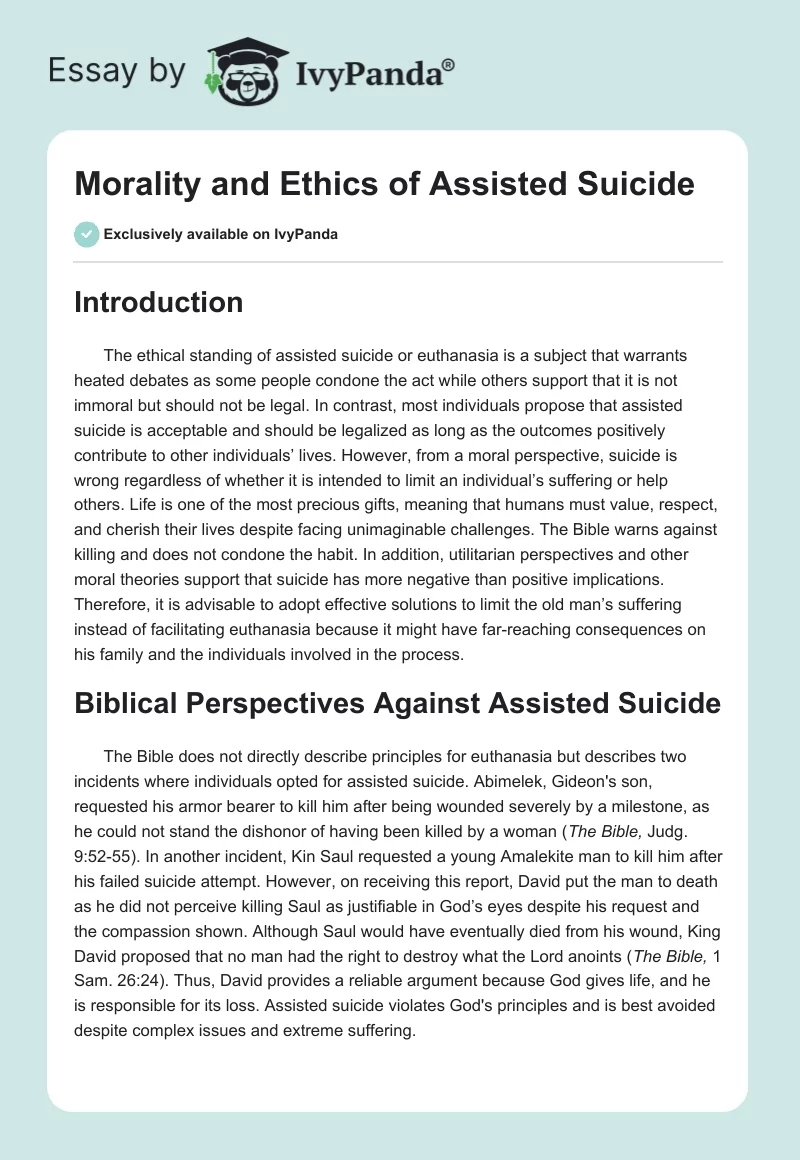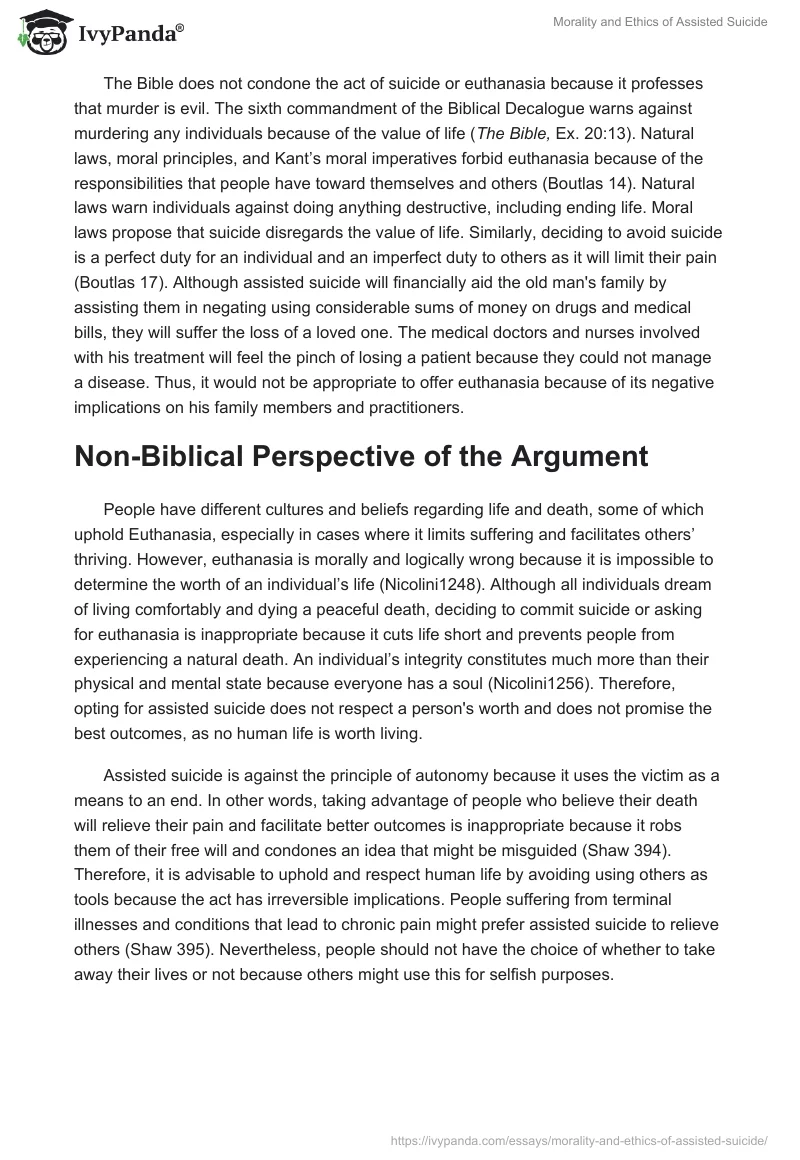Introduction
The ethical standing of assisted suicide or euthanasia is a subject that warrants heated debates as some people condone the act while others support that it is not immoral but should not be legal. In contrast, most individuals propose that assisted suicide is acceptable and should be legalized as long as the outcomes positively contribute to other individuals’ lives. However, from a moral perspective, suicide is wrong regardless of whether it is intended to limit an individual’s suffering or help others. Life is one of the most precious gifts, meaning that humans must value, respect, and cherish their lives despite facing unimaginable challenges. The Bible warns against killing and does not condone the habit. In addition, utilitarian perspectives and other moral theories support that suicide has more negative than positive implications. Therefore, it is advisable to adopt effective solutions to limit the old man’s suffering instead of facilitating euthanasia because it might have far-reaching consequences on his family and the individuals involved in the process.
Biblical Perspectives Against Assisted Suicide
The Bible does not directly describe principles for euthanasia but describes two incidents where individuals opted for assisted suicide. Abimelek, Gideon’s son, requested his armor bearer to kill him after being wounded severely by a milestone, as he could not stand the dishonor of having been killed by a woman (The Bible, Judg. 9:52-55). In another incident, Kin Saul requested a young Amalekite man to kill him after his failed suicide attempt. However, on receiving this report, David put the man to death as he did not perceive killing Saul as justifiable in God’s eyes despite his request and the compassion shown. Although Saul would have eventually died from his wound, King David proposed that no man had the right to destroy what the Lord anoints (The Bible, 1 Sam. 26:24). Thus, David provides a reliable argument because God gives life, and he is responsible for its loss. Assisted suicide violates God’s principles and is best avoided despite complex issues and extreme suffering.
The Bible does not condone the act of suicide or euthanasia because it professes that murder is evil. The sixth commandment of the Biblical Decalogue warns against murdering any individuals because of the value of life (The Bible, Ex. 20:13). Natural laws, moral principles, and Kant’s moral imperatives forbid euthanasia because of the responsibilities that people have toward themselves and others (Boutlas 14). Natural laws warn individuals against doing anything destructive, including ending life. Moral laws propose that suicide disregards the value of life. Similarly, deciding to avoid suicide is a perfect duty for an individual and an imperfect duty to others as it will limit their pain (Boutlas 17). Although assisted suicide will financially aid the old man’s family by assisting them in negating using considerable sums of money on drugs and medical bills, they will suffer the loss of a loved one. The medical doctors and nurses involved with his treatment will feel the pinch of losing a patient because they could not manage a disease. Thus, it would not be appropriate to offer euthanasia because of its negative implications on his family members and practitioners.
Non-Biblical Perspective of the Argument
People have different cultures and beliefs regarding life and death, some of which uphold Euthanasia, especially in cases where it limits suffering and facilitates others’ thriving. However, euthanasia is morally and logically wrong because it is impossible to determine the worth of an individual’s life (Nicolini1248). Although all individuals dream of living comfortably and dying a peaceful death, deciding to commit suicide or asking for euthanasia is inappropriate because it cuts life short and prevents people from experiencing a natural death. An individual’s integrity constitutes much more than their physical and mental state because everyone has a soul (Nicolini1256). Therefore, opting for assisted suicide does not respect a person’s worth and does not promise the best outcomes, as no human life is worth living.
Assisted suicide is against the principle of autonomy because it uses the victim as a means to an end. In other words, taking advantage of people who believe their death will relieve their pain and facilitate better outcomes is inappropriate because it robs them of their free will and condones an idea that might be misguided (Shaw 394). Therefore, it is advisable to uphold and respect human life by avoiding using others as tools because the act has irreversible implications. People suffering from terminal illnesses and conditions that lead to chronic pain might prefer assisted suicide to relieve others (Shaw 395). Nevertheless, people should not have the choice of whether to take away their lives or not because others might use this for selfish purposes.
Utilitarian Perspectives
Utilitarian theorists reason in terms of maximizing happiness and minimizing suffering. Therefore, their perceptions of the morality of euthanasia take different standings considering its implications and outcomes (Binder 65). For example, an individual suffering from an untreatable illness experiences great suffering and might not feel the value of their life. In this case, utilitarian theorists argue that it is right to facilitate assisted suicide because it will rid the victim of their suffering once and for all (Binder 65). However, it is unreasonable to consider the effects of assisted suicide on individuals because their families, partners, and others in their social circle may not experience benefits.
An individual’s decision to commit suicide is heartbreaking news for those close to them because it sends a negative message. Therefore, judging by the Utilitarian perspective, it is wrong and impermissible to deliver assisted suicide because of the suffering that comes with grieving and the pain of realizing that a victim died an immature death (Van der Haak 160). In addition, assisted suicide goes against the physician’s principle of not harm because a medical practitioner is directly involved in ending their patient’s life (Van der Haak 164). Thus, assisted suicide is unacceptable and should be avoided because it goes against the laws of nature, is irreversible, and can facilitate suffering.
Conclusion
Assisted suicide is a medical process where a physician delivers medication to suffering patients to end their lives and relieve their pain. Therefore, the procedure promises to deal with an individual’s issues but offsets several other moral principles. For example, the Ten Commandments warn against killing because only God gives and takes away life. In addition, euthanasia is immoral because it limits people from achieving perfect and imperfect duties. Finally, assisted suicide does not promise the best outcomes as it leads to others suffering despite abolishing the victim’s pain. Therefore, it does not stand with utilitarian perspectives of avoiding harm and maximizing benefits. Although a person might suffer and not desire an uncomfortable future, assisted suicide is against several tenets of morality and is an irreversible act. Hence, practitioners should avoid the procedure at all costs.
Works Cited
Binder, Guyora, and Luis Chiesa. “The puzzle of inciting suicide.” Am. Crim. L. Rev. 56. 2019: 65. Web.
Boutlas, George. “The problem of priority of principles in bioethics. Can the Kantian classification of perfect and imperfect duties help us?.” Ηθική. Περιοδικό φιλοσοφίας 13 (2020): 13-21. Web.
Nicolini, Marie E., et al. “Should euthanasia and assisted suicide for psychiatric disorders be permitted? A systematic review of reasons.” Psychological Medicine 50.8 2020: 1241–1256. Web.
Shaw, David, Manuel Trachsel, and Bernice Elger. “Assessment of decision-making capacity in patients requesting assisted suicide.” The British Journal of Psychiatry 213.1 2018: 393–395. Web.
The Bible. The New Oxford Annotated Version, 3rd ed., Oxford UP, 2001
Van der Haak, Donovan. “Death Anxiety, Immortality Projects and Happiness: A Utilitarian Argument Against the Legalization of Euthanasia.” Conatus-Journal of Philosophy 6.1 2021: 159–174. Web.


